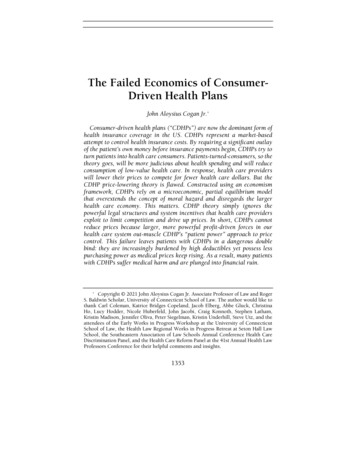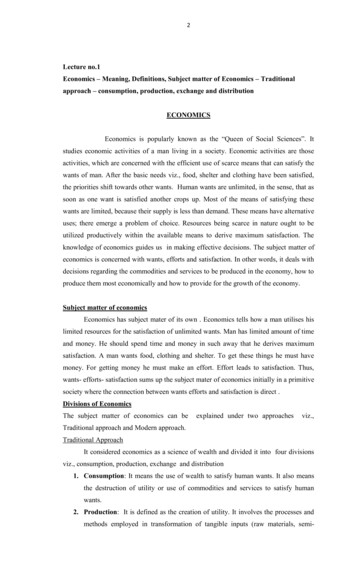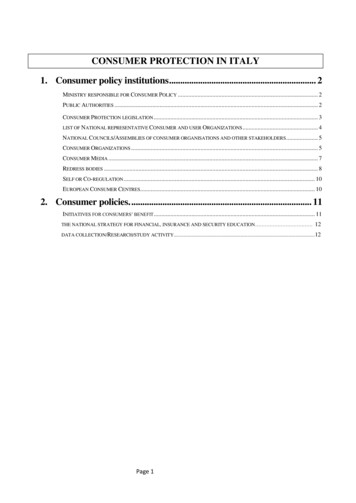
Transcription
The Failed Economics of ConsumerDriven Health PlansJohn Aloysius Cogan Jr.*Consumer-driven health plans (“CDHPs”) are now the dominant form ofhealth insurance coverage in the US. CDHPs represent a market-basedattempt to control health insurance costs. By requiring a significant outlayof the patient’s own money before insurance payments begin, CDHPs try toturn patients into health care consumers. Patients-turned-consumers, so thetheory goes, will be more judicious about health spending and will reduceconsumption of low-value health care. In response, health care providerswill lower their prices to compete for fewer health care dollars. But theCDHP price-lowering theory is flawed. Constructed using an economismframework, CDHPs rely on a microeconomic, partial equilibrium modelthat overextends the concept of moral hazard and disregards the largerhealth care economy. This matters. CDHP theory simply ignores thepowerful legal structures and system incentives that health care providersexploit to limit competition and drive up prices. In short, CDHPs cannotreduce prices because larger, more powerful profit-driven forces in ourhealth care system out-muscle CDHP’s “patient power” approach to pricecontrol. This failure leaves patients with CDHPs in a dangerous doublebind: they are increasingly burdened by high deductibles yet possess lesspurchasing power as medical prices keep rising. As a result, many patientswith CDHPs suffer medical harm and are plunged into financial ruin.* Copyright 2021 John Aloysius Cogan Jr. Associate Professor of Law and RogerS. Baldwin Scholar, University of Connecticut School of Law. The author would like tothank Carl Coleman, Katrice Bridges Copeland, Jacob Elberg, Abbe Gluck, ChristinaHo, Lucy Hodder, Nicole Huberfeld, John Jacobi, Craig Konnoth, Stephen Latham,Kristin Madison, Jennifer Oliva, Peter Siegelman, Kristin Underhill, Steve Utz, and theattendees of the Early Works in Progress Workshop at the University of ConnecticutSchool of Law, the Health Law Regional Works in Progress Retreat at Seton Hall LawSchool, the Southeastern Association of Law Schools Annual Conference Health CareDiscrimination Panel, and the Health Care Reform Panel at the 41st Annual Health LawProfessors Conference for their helpful comments and insights.1353
1354University of California, Davis[Vol. 54:1353TABLE OF CONTENTSINTRODUCTION . 1355I. CDHPS AND THE THINNING OF HEALTH INSURANCE . 1365A. CDHPs are the New Normal . 1366B. The Growth of Deductibles . 1368C. The Harms of CDHPs . 13691. Reduced Medical Care . 13692. Financial Harms . 1370a. Greater Financial Risk . 1370b. Medical Debt . 1371c. Medical Bankruptcies . 1373d. Aggressive Debt Collection . 1374e. New Medical Charity . 1374II. FROM MORAL PERFIDY TO ORTHODOX ECONOMICS . 1376A. Health Insurance Deductibles . 13771. Blue Cross and First Dollar Coverage . 13772. The Deductible as Standard Insurance Tool . 1379B. The Shift from Morality to Economics. 13801. Arrow: Moral Hazard as Market Failure . 13802. Mark Pauly: Moral Hazard as Rational Behavior . 1381C. Free Medical Care and the Deductible . 1382D. Limitations of the Model . 13871. Where Pauly’s Model Leaves Us . 1390E. RAND HIE and Measurement of Moral Hazard . 1390III. ECONOMISM AND CDHPS . 1394A. Free Market Economics . 1394B. Free Market Health Care . 1395C. Economism and CDHPs . 13971. Economism . 13972. The Laws of Supply and Demand . 1398D. History and the Flaws of CDHP Price Theory . 1400IV. FAILURE OF THE CDHP PRICE THEORY . 1400A. Lack of Competition . 14021. Concentrated Markets for Hospitals and Physicians 1404B. Government-protected Monopoly Rights for DrugManufacturers . 1407C. Shenanigans to Maintain High Prices . 14091. Secret Contractual Terms . 14092. Drug Coupons . 14103. Other Ways to Maintain High Prices . 1412D. Evolving Insurance Markets. 14131. Gap Coverage . 1413
2021]The Failed Economics of CDHPs13552. Limited Networks . 1414V. POST-CDHP HEALTH INSURANCE? . 1415A. Can We Escape the High Deductible Trap? . 1416B. Can Deductibles Be Reformulated to Actually LowerPrices? . 14191. Benefit Design and Patient Choice . 1419a. Tiered Pricing. 1419b. Reference-based Benefits . 1420c. Centers of Excellence . 14212. Choice Architecture, Patient Choice, andBureaucracy . 1422C. Honoring Autonomy, Market Choice, and IndividualContracting . 1424CONCLUSION. 1427INTRODUCTIONConsumer-driven health plans (“CDHPs”) are quietly pushingAmericans toward a national health care calamity. CDHPs, thedominant form of health insurance in the U.S.,1 impose large annualdeductibles — typically thousands of dollars2 — based on the theorythat significant cost-sharing will transform patients into cost-consciousconsumers.3 Patients-turned-consumers, the theory holds, will shop forhealth care, compare prices, and decrease consumption of unnecessarymedical services.4 In response, health care providers will compete forpatients by lowering their prices.5 But CDHP theory has not matched1See infra notes 69–70 and accompanying text.See infra notes 72–75 and accompanying text.3 M. Kate Bundorf, Consumer-Directed Health Plans: A Review of the Evidence, 83 J.RISK & INS. 9, 9 (2016); see Jon R. Gabel, Anthony T. Lo Sasso & Thomas Rice,Consumer-Driven Health Plans: Are They More than Talk Now?, 21 HEALTH AFF. W395,W395-96 (2002).4 On one point, CDHP advocates are correct: high deductibles reduce consumptionof medical care. Indeed, the spending reductions generated by CDHPs are notinsubstantial. One estimate predicts that adoption of CDHPs by half of all employerswill cut annual health care spending by 57 billion. Amelia M. Haviland, M. SusanMarquis, Roland D. McDevitt & Neeraj Sood, Growth of Consumer-Directed Health Plansto One-Half of All Employer-Sponsored Insurance Could Save 57 Billion Annually, 31HEALTH AFF. 1009, 1010 (2012) [hereinafter Growth]. The spending reductions,however, are indiscriminate. Patients reduce both necessary and unnecessary care. Seeinfra Part I.C.1.5 Competition for consumer demand is often touted as the cure for high healthcare prices. See, e.g., Regina E. Herzlinger, Let’s Put Consumers in Charge of Health Care,80 HARV. BUS. REV. 44, 45 (2002) (“[C]onsumer-driven health care would . . . enabl[e]2
1356University of California, Davis[Vol. 54:1353reality; CDHPs have not driven down prices. Instead, CDHPs havegnawed away insurance coverage while medical prices have soared. Formillions of Americans, the failure of the CDHP theory has led tofinancial and medical catastrophe.Insured Americans are drowning in medical debt.6 The data arestartling. While more than 90% of Americans have health insurance,7over 137 million U.S. adults now face medical financial hardships.8 Oneproviders and patients jointly to create better, cheaper ways to deliver care.”); MikeBraun, Opinion, Health Care Needs Transparency, and President Trump Is MakingProgress, HILL (July 1, 2019, 10:45 AM EDT), nt-trump-is-making[https://perma.cc/5S3D-UG3N] (“[W]e can include consumers in the negotiation bygiving them some skin in the game - encouraging them to shop around for prices likewe do for car insurance and big screen TVs - then competition will do what it does inall other industries: lower prices.”); Allan B. Hubbard, Opinion, The Health of a Nation,N.Y. TIMES (Apr. 3, 2006), lthof-a-nation.html [https://perma.cc/X4TC-748P] (“Informed consumers could bringdown costs throughout the health care industry by choosing only high-value care,making providers raise quality and lower prices to compete for their business . . . .”);George A. Nation III, Opinion, Three Doses of Competition to Reduce the Soaring Cost ofHealth Care, HILL (Mar. 4, 2018, 11:00 AM EST), of-healthcare [https://perma.cc/3KHX-MQLR] (arguing that encouraging competition amonghealth care providers for patients will drive down provider prices); Seema Verma,Competition as the Engine for Lowering Healthcare Costs, CENTERS FOR MEDICARE &MEDICAID SERVICES BLOG (June 6, 2019), g-healthcare-costs [https://perma.cc/S6BQ-47G9] (“Only a truly free andcompetitive market will provide patients with more choices that can deliver both lowercosts and higher quality.”). To be clear, some forms of competition can drive downprices. For example, more competition among large and sophisticated repeat players inthe medical marketplace can lead to lower prices. See, e.g., Laurence C. Baker, M. KateBundorf, Anne B. Royalty & Zachary Levin, Physician Practice Competition and PricesPaid by Private Insurers for Office Visits, 312 JAMA 1653, 1659 (2014) (finding thathigher competition among physician practice groups can lead to lower prices paid byprivate insurance companies to physicians for office visits). CDHPs, on the other hand,look to patients-as-consumers as the mechanism to stimulate competition amongproviders and drive down prices.6 See Margot Sanger-Katz, Even Insured Can Face Crushing Medical Debt, Study Finds,N.Y. TIMES (Jan. 5, 2016), edical-debt.html [https://perma.cc/7YR4-87T2](noting that “the majority of people struggling with [medical] bills are insured”).7 EDWARD R. BERCHICK, JESSICA C. BARNETT & RACHEL D. UPTON, U.S. CENSUSBUREAU, CURRENT POPULATION REPORTS P60-267 (RV), HEALTH INSURANCE COVERAGE INTHE UNITED STATES: 2018, at 3 (2019), publications/2019/demo/p60-267.pdf [https://perma.cc/6QCT-9BV8].8 K. Robin Yabroff, Jingxuan Zhao, Xuesong Han & Zhiyuan Zheng, Prevalence andCorrelates of Medical Financial Hardship in the USA, 34 J. GEN. INTERNAL MED. 1494,1496 (2019) (finding that “56.0% of adults reported any medical financial hardship,
2021]The Failed Economics of CDHPs1357in four Americans adults say they or someone in their household hadtrouble paying their medical bills during the prior year.9 Indeed,medical debt is the top reason debt collectors contact Americans.10 And,nearly two-thirds of people who file for bankruptcy cite medical issuesas a key contributor to their financial downfall.11Patients facing large deductibles also reduce their use of necessarymedical care. According to one study, 43% of insured patients reportedthat they or a family member delayed or skipped physicianrecommended tests or treatments because of high out-of-pocket costs.12CDHPs have hit the chronically ill13 even harder. Three-quarters ofpatients with chronic conditions who face very high deductibles (atleast 3,000 for an individual or 5,000 for a family)14 report that theyskipped or postponed necessary medical care or prescription drugs forrepresenting 137.1 million adults”). More than half of Americans aged eighteen to sixtyfour have problems with medical bills or medical debt, suffer stress about householdfinanced because of medical debt, or forego or delay necessary medical care becausethey cannot afford it. Id. at 1501.9 LIZ HAMEL, MIRA NORTON, KAREN POLLITZ, LARRY LEVITT, GARY CLAXTON &MOLLYANN BRODIE, THE BURDEN OF MEDICAL DEBT: RESULTS FROM THE KAISER FAMILYFOUNDATION/NEW YORK TIMES MEDICAL BILLS SURVEY 1 (2016), rvey.pdf [https://perma.cc/FA4URTCG] [hereinafter N.Y. TIMES SURVEY].10 CONSUMER FIN. PROT. BUREAU, CONSUMER EXPERIENCES WITH DEBT COLLECTION:FINDINGS FROM THE CFPB’S SURVEY OF CONSUMER VIEWS ON DEBT 21 ts/201701 cfpb Debt-Collection-SurveyReport.pdf [https://perma.cc/8B4C-6YSG] [hereinafter CONSUMER EXPERIENCES]. Morethan half of all debt on credit reports is from medical expenses. Michelle Andrews, YourCredit Score Soon Will Get a Buffer from Medical-Debt Wrecks, KAISER HEALTH NEWS (July11, 2017), et-a-buffer-from-medicaldebt-wrecks/ [https://perma.cc/28Z5-MNYJ].11 See David U. Himmelstein, Robert M. Lawless, Deborah Thorne, Pamela Foohey& Steffie Woolhandler, Medical Bankruptcy: Still Common Despite the Affordable CareAct, 109 AM. J. PUB. HEALTH 431, 432 (2019).12 See HAMEL ET AL., N.Y. TIMES SURVEY, supra note 9, at 16.13 The chronically ill suffer from “a physical or mental health condition that lastsmore than one year and causes functional restrictions or requires ongoing monitoringor treatment.” CHRISTINE BUTTORFF, TEAGUE RUDER & MELISSA BAUMAN, RAND CORP.,MULTIPLE CHRONIC CONDITIONS IN THE UNITED 1.html [https://perma.cc/5622-DNJC]. Chronicconditions include diabetes, hypertension, and mood disorders. Id.14 See LIZ HAMEL, CAILEY MUÑANA & MOLLYANN BRODIE, KAISER FAMILYFOUNDATION/LA TIMES SURVEY OF ADULTS WITH EMPLOYER-SPONSORED HEALTH INSURANCE1 (2019), nsurance [https://perma.cc/JJ2G-9KYB] [hereinafter L.A.TIMES SURVEY] (defining “highest deductibles”).
1358University of California, Davis[Vol. 54:1353cost reasons over the previous year.15 Moreover, the toxicity of medicaldebt is so profound that more than three-quarters of insured familiesburdened by medical debt cut back spending on food, clothes, housing,and other household essentials.16 Physicians have also expressedconcern that patients subject to high deductibles and other forms ofcost-sharing will “cut corners in ways that may affect their health andwell-being.”17Criticism of CDHPs is not new. Since their inception in 2003,18CDHPs have drawn sharp condemnation from scholars and healthpolicy experts. These critiques largely focused on the functionaldeficiencies of CDHPs. Some critics noted that patients lacked the priceinformation necessary to shop for medical care.19 Others found littleevidence patients actually shopped for medical services, even whenprices were available.20 Some also complained that patients with CDHPsindiscriminately curtailed medical care, cutting back on both necessaryand unnecessary services.21 Despite these criticisms, sales of CDHPs15See id. at 2.See HAMEL ET AL., N.Y. TIMES SURVEY, supra note 9, at 15.17 Peter A. Ubel, Amy P. Abernethy & S. Yousuf Zafar, Full Disclosure — Out-ofPocket Costs as Side Effects, 369 NEW ENG. J. MED. 1484, 1485 (2013).18 See infra notes 65–67 and accompanying text.19 See, e.g., TIMOTHY STOLTZFUS JOST, HEALTH CARE AT RISK 143-44 (2007) (findingthat consumers are not provided with enough information regarding medical costs andquality); U.S. GOV’T ACCOUNTABILITY OFFICE, GAO-11-791, HEALTH CARE PRICETRANSPARENCY: MEANINGFUL PRICE INFORMATION IS DIFFICULT FOR CONSUMERS TO OBTAINPRIOR TO RECEIVING CARE (2011), rma.cc/9RLK-X972] (noting that patients lack access to price information formedical services).20 See, e.g., Katherine M. Harris, How Do Patients Choose Physicians? Evidence froma National Survey of Enrollees in Employment-Related Health Plans, 38 HEALTH SERVICESRES. 711, 729 (2003) (finding that patients are passive consumers of physician services);Ateev Mehrotra, Katie M. Dean, Anna D. Sinaiko & Neeraj Sood, Americans SupportPrice Shopping for Health Care, but Few Actually Seek Out Price Information, 36 HEALTHAFF. 1392, 1392 (2017) (“Only 13 percent of survey respondents who had some outof-pocket [medical] spending . . . sought [price] information . . . before receiving care,and just 3 percent compared costs across providers before receiving care.”); MichaelChernew, Zack Cooper, Eugene Larsen-Hallock & Fiona Scott Morton, Are Health CareServices Shoppable? Evidence from the Consumption of Lower-Limb MRI Scans 1 (Nat’lBureau of Econ. Research, Working Paper No. 24869, 2018) (“Despite significant outof-pocket costs and little variation in quality, patients often received care in high-pricedlocations when lower priced options were available.”).21 See, e.g., TIFFANY CHAN & NANCY TURNBULL, ASSESSMENT OF THE IMPACT OF HIGHDEDUCTIBLE HEALTH PLANS ON PATIENT HEALTH AND THE FINANCIAL IMPACT ON MEDICALPRACTICES 10 (2017), http://www.massmed.org/highdeductible/ [https://perma.cc/MBY3DBZD] (“[T]here is a substantial amount of evidence that, when faced with increasedcost-sharing, consumers often indiscriminately reduce their use of health cares,16
2021]The Failed Economics of CDHPs1359have surged — along with the size of deductibles. Today, CDHPs notonly dominate health insurance, but many CDHP policies also carryextremely large deductibles — some exceeding 15,000.22 Advocates ofCDHPs have responded to these criticisms by arguing for more pricetransparency and improved shoppability of medical services.23Consumer power, they argue, is the key to bringing down prices. AsU.S. Senator Mike Braun noted in a recent op-ed arguing for increasedmedical price transparency, “If we can . . . [encourage health careconsumers] to shop around for prices like we do for car insurance andbig screen TVs — then competition will do what it does in all otherindustries: lower prices.”24This Article offers a new critique of CDHPs. Rather than focusing ontheir functional shortcomings, this Article attacks the theoreticaldeficiencies of CDHPs. In short, CDHPs have not only failed in practice,they also fail in theory. The CDHP model simply does not account forthe nature and complexity of health care markets, existing legalstructures, and information asymmetries. This failure leaves patientswith CDHPs in a dangerous double bind: they are increasinglyburdened by high deductibles yet possess less purchasing power asmedical prices keep rising.The defect of CDHP theory stems from two factors. First, the theoryoverextends the economic concept of moral hazard. The centralproblem plaguing health insurance, according to CDHP theory, is moralhazard — the idea that health insurance can cause patients to use toomuch medical care. Although the notion of moral hazard has existedincluding reducing use of high-value care.”); Rajender Agarwal, Olena Mazurenko &Nir Menachemi, High-Deductible Health Plans Reduce Health Care Cost and Utilization,Including Use of Needed Preventive Services, 36 HEALTH AFF. 1762, 1765 (2017)(providing summary of studies showing CDHP enrollees reduce appropriate andinappropriate medical care); Amelia M. Haviland, Matthew D. Eisenberg, AteevMehrotra, Peter J. Huckfeldt & Neeraj Sood, Do “Consumer-Directed” Health Plans Bendthe Cost Curve Over Time?, 46 J. HEALTH ECON. 33, 34 (2016) (“More recentobservational studies have . . . provided evidence that CDHP enrollees reduce somenecessary preventive and chronic care.”).22 Aimee Picchi, Higher Health Insurance Deductibles a Sickening Trend forAmericans, CBS NEWS (June 13, 2019, 3:34 PM), cial-hardship/[https://perma.cc/F332-CPTK] (“Some insurance company plans now carry deductiblesof more than 7,000 for an individual and 15,000 for families.”).23 See, e.g., Braun, supra note 5 (calling for transparency in the U.S. health caremarket).24 Id.
1360University of California, Davis[Vol. 54:1353since the 1800s,25 economist Mark Pauly reframed the concept in hisseminal 1968 article, The Economics of Moral Hazard: Comment.26 Paulywas responding to Nobel laureate Kenneth Arrow’s groundbreaking1963 article Uncertainty and the Welfare Economics of Medical Care.27Arrow’s article considered why the market did not provide completehealth insurance coverage. The problem, as Arrow saw it, was a lack ofinformation and market uncertainty. Insurers responded to thesemarket failures by reducing coverage to limit their own risk.28 Inresponse, Pauly argued that full coverage may not be optimal becauseof moral hazard. Health insurance, Pauly argued, causes a rational, butwelfare-decreasing overconsumption of “free” medical care.29 Since apatient’s demand for medical care is to some extent discretionary, a fullyinsured patient will overconsume medical care because he or she is notsensitive to the price of medical care. In other words, full insurance actslike a subsidy.30 The solution, according to Pauly, is to realign patients’purchasing incentives through cost-sharing mechanisms, such asdeductibles.31 Shifting medical costs back to patients will, Pauly argued,reduce moral hazard by driving down consumption of low-valuemedical care.32 This, in turn, will reduce the aggregate cost of coverageand lower premiums.33Pauly’s theory of moral hazard focuses on the efficient consumptionof medical care when a patient is insured; it does not speak to the issueof high medical prices and does not purport to apply to all types ofmedical care. Nevertheless, in the 1990s, pro-market pressure groupsand neoliberal policy advocates incorporated Pauly’s conception of25 Tom Baker, On the Genealogy of Moral Hazard, 75 TEX. L. REV. 237, 250 (1996)(“For nineteenth century insurers, moral hazard was a label applied both to people andsituations.”).26 Mark V. Pauly, The Economics of Moral Hazard: Comment, 58 AM. ECON. REV. 531(1968).27 Kenneth J. Arrow, Uncertainty and the Welfare Economics of Medical Care, 53 AM.ECON. REV. 941 (1963). Arrow’s article is viewed as the beginning of modern healtheconomics. Victor Fuchs, Kenneth Arrow’s Legacy and the Article That Launched aThousand Studies, HEALTH AFF. BLOG (Mar. 8, 2017), 0308.059100/full/ [https://perma.cc/X99G-XD6J] (“In a singlearticle published by the American Economic Review in 1963, he launched modern healtheconomics.”).28 See infra notes 163–70 and accompanying text.29 See Pauly, supra note 26, at 535-36.30 See Joseph P. Newhouse & Vincent Taylor, The Subsidy Problem in HospitalInsurance: A Proposal, 43 J. BUS. 452, 452 (1970).31 See Pauly, supra note 26, at 535-36.32 See id.33 See id. at 534-36.
2021]The Failed Economics of CDHPs1361moral hazard into their theory of CDHPs34 using an analytic frameworkcalled economism. Their use of the economism framework leads to thesecond — and fatal — defect of the CDHP theory.Economism is the inapt use of microeconomic concepts to promotesimple policy solutions to complex societal problems.35 In short,economism collapses economic theory into a dogmatic approach topolicymaking, one that skews policy recommendations toward limitedgovernment, competitive markets, and heightened consumerresponsibility. Using the economism framework, advocates argued thatCDHPs would lower health insurance premiums by giving patients“more skin in the game.”36 By requiring a significant outlay of thepatient’s own money before insurance payments begin, CDHPs would,so the argument goes, turn patients into cost-conscious consumers whowill reduce consumption of unnecessary care and drive down medicalprices.The power of economism rests on its simple solutions and the cloutof economics. Economism produces policy solutions that seem to reflectthe “science” of economics, but only in a simplistic version that can beeasily understood and effortlessly explained. Since economism34See JOST, supra note 19, at 30-34.JAMES KWAK, ECONOMISM: BAD ECONOMICS AND THE RISE OF INEQUALITY 6-8 (2017)(noting that while the term “economism” is “generally used to criticize someone forovervaluing economics” he uses the term to refer to the use of simplistic, textbook“Economics 101” principles as accurate descriptions of empirical reality). According toeconomist-turned-journalist Noah Smith, the phenomenon reflects the flawedapplication of concepts taught in “Economics 101” classes:35We all know basically what 101ism says. Markets are efficient. Firms arecompetitive. Partial-equilibrium supply and demand describes most things.Demand curves slope down and supply curves slope up. Only one curve shiftsat a time. No curve is particularly inelastic or elastic; all are somewhere in themiddle (straight lines with slopes of 1 and -1 on a blackboard). Etc.Note that 101 classes don’t necessarily teach that these things are true! . . .But for some reason, people seem to come away from 101 classes thinking thatthe cases that are the easiest to draw on the board are - God only knows why- the benchmark cases.Noah Smith, 101ism, NOAHPINION (Jan. 21, 2016), html [https://perma.cc/7XBA-YPE3].36 See KWAK, supra note 35, at 112-13 (quoting John F. Cogan, R. Glenn Hubbard& Daniel P. Kessler, Opinion, Healthy, Wealthy and Wise, WALL ST. J. (May 4, 2004,12:01 AM ET), https://www.wsj.com/articles/SB108362681322500884 [https://perma.cc/27DR-XZVE] (“Higher copayments will give consumers more ‘skin in the game,’ makingthem more cost-conscious and more willing to take greater control of health-caredecisions.”)).
1362University of California, Davis[Vol. 54:1353produces policy solutions that are propelled by ideology rather thanempirical analysis, debates about economism-driven policies tend to bemore rhetorical than analytical.37 CDHP advocates have forcefullyresponded to prior criticism by arguing for more “transparency” and“competition” in health care markets. In a rare instance of agreementamong the left and right,38 the Obama and Trump administrations, aswell as state governments, have promoted medical price transparencyand health care shoppability as price cost control strategies.39But increased price transparency and medical shoppability will not —cannot — drive down prices. CDHPs fail because they representeconomism at its worst: an unflinching reliance on a simplistic partialequilibrium model that oversimplifies the price problem andconceptualizes the health care economy too narrowly. In short, CDHPtheory flops because it identifies the wrong problem and specifies thewrong solution. Even if applied as their advocates intend, CDHPssimply do not work as a means to control medical prices.This Article advances three core claims. First, CDHPs cannot reducemedical prices because larger, more powerful profit-driven forces in ourhealth care system out-muscle CDHP’s “patient power” approach toprice control. Although CDHPs reduce overall spending by reducingdemand, the supply of medical care is not driven by patient choice. Evenif patients are rationed by price (which they are, through high37 See id. at 11 (noting that one of economism’s strengths is its ability “to pass asabstract science rather than rhetorical device”).38 See Joel White, Promoting Transparency and Clear Choices in Health Care, HEALTHAFF. BLOG (June 9, 2015), 0609.048337/full/ [https://perma.cc/9EMP-8R4F] (“Politically, both Democrats andRepublicans see value in transparency. . . . Both parties seem to want an empoweredconsumer.”).39 On November 15, 2019, the Trump administration issued two rules, one finaland one proposed, to increase price transparency in health care. See Medicare andMedicaid Programs: CY 2020 Hospital Outpatient PPS Policy Changes and PaymentRates and Ambulatory Surgical Center Payment System Policy Changes and PaymentRates. Price Transparency Requirements for Hospitals to Make Standard Charges Public,84 Fed. Reg. 65,524 (Nov. 27, 2019) (to be codified at 45 C.F.R. pt. 180) (effective onJan. 1, 2021); Transparency in Coverage, 84 Fed. Reg. 65,464 (proposed Nov. 27, 2019)(to be codified at 45 C.F.R. pts. 147 and 158). The Obama administration released thelist prices charged by hospitals participating in Medicare for common hospital services.See Jeffrey Young & Chris Kirkham, Hospital Prices No Longer Secret as New DataReveals Bewildering System, Staggering Cost Differences, HUFFPOST (May 8, 2013, 1
Consumer-driven health plans ("CDHPs") are quietly pushing Americans toward a national health care calamity. CDHPs, the dominant form of health insurance in the U.S.,1 impose large annual deductibles — typically thousands of dollars2 — based on the theory that significant cost-sharing will transform patients into cost-conscious











